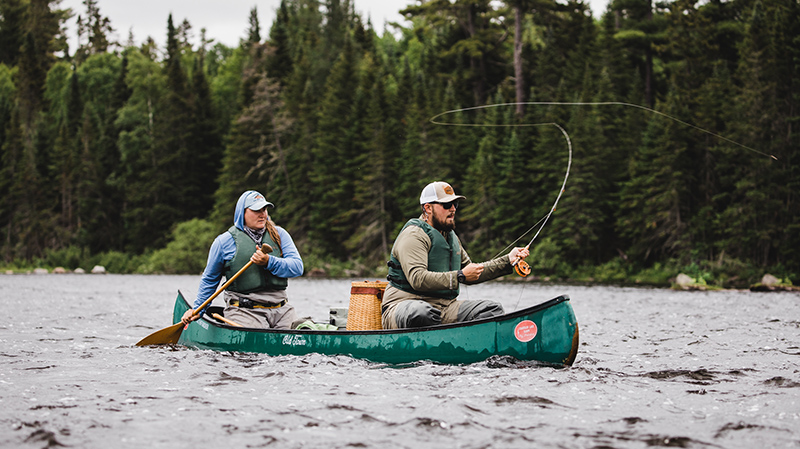Fly Fishing 101: Aquatic Insects Of Fly Fishing
This article is part of a series by Old Town Pro Staff member Megan Hess. Megan is the founder of BeadHead Fishing Company, a guide service and fly tying company based out of Hudson, Maine. She has her bachelors degree in aquatic biology and a masters degree in ecology and environmental sciences. She researched mercury contamination in waterbodies using aquatic insects for 8+ years. She is a Registered Maine Fishing Guide, a commercial fly tyer, and a guide for Chandler Lake Camps and Lodge.

I’ve been asked this question tons of times, “So, did you like bugs or did fly fishing make you learn about bugs?”
I was taught to fly fish when I was young by my grandfather. I would toss little Betts Poppers for panfish in small Wisconsin ponds. Fast forward some years at the University of Wisconsin - La Crosse during undergrad, I took my first entomology class as an elective for my biology degree. The class was called “The Ecology of Freshwater Invertebrates” and the first day my professor said we would mostly focus on aquatic insects. I remember being immediately bummed because I wanted to learn about things like crayfish and mussels, not “bugs.” Oh how little I knew because by the end of the semester I had decided that I was going to change my degree focus. I quickly became obsessed with everything related to aquatic insects. I started researching mercury contamination in waterbodies using aquatic insects after classes in the laboratory. During this time I also started to relate what I was studying to my hobby of fly fishing in the Driftless region of Wisconsin. I graduated from the University of Wisconsin - La Crosse with a bachelor’s degree in aquatic biology and chemistry. I wanted to continue to research mercury contamination using aquatic insects and went on to the University of Maine to receive a master’s degree in ecology and environmental studies with a focus in entomology and toxicology.
As I taught fly fishing classes to different fishing groups during graduate school, I learned that most anglers had so many questions about the entomology portion and most had been very interested in it but didn’t have the right materials to learn more about it. This is when I decided I would offer aquatic entomology classes with high quality science material that the general public can understand. Here, I want to give you a brief introduction to the major orders of aquatic insects that are discussed in fly fishing and how to identify them.
Kingdom: Animalia
Phylum: Arthropoda = exoskeleton and jointed legs as adult
Class: Insecta = has six legs as an adult
Orders: Ephemeroptera, Plecoptera, Trichoptera, Diptera
EPHEMEROPTERA (MAYFLIES)
Mayflies are the most primitive aquatic insects, evolving nearly 400 million years ago! Their general body layout consists of a head, thorax that contains the legs, abdomen, and tails. Important things to look for when identifying mayfly nymphs are the feather-like gills on the sides of their abdomen, one tarsal claw at the end of each forearm, and 3 tails (or cerci). Adults will have their wings high up when they land and will resemble little sailboats on the water. Additionally, mayfly adults may have two or three tails depending on the species.
PLECOPTERA (STONEFLIES)
Stonefly nymphs can look very similar to mayfly nymphs in that they have very distinct body regions like a head, thorax, abdomen, and tails. However, stonefly nymphs have gills on their thorax, not their abdomen, and two tails, not three. Additionally, they will have two tarsal claws at the end of their forearms, not just one. Stonefly adults have wings that are capable of folding over the top of each other and thus their wings are flat on top of their backs when they land.
TRICHOPTERA (CADDISFLIES)
Caddisflies are closely related to moths and caterpillars and thus, they also have silk glands that they can use to produce cases of fine sticks, leaves, or sand that they live in. Like mayfly and stonefly nymphs, caddisfly larvae have 6 jointed legs. They pop out of their cases and use these legs to crawl around while dragging their cases along. They have a soft grub-like abdomen with two terminal hooks off the hind-end to anchor themselves into their cases. However, not all caddisfly species create cases which are then considered free-living caddis. Caddisfly adults resemble moths with their powdery wings and when they land their wings will create what resembles a tent. This is unlike mayflies that have their wings flat and up, and unlike stoneflies that have their wings flat and down.
DIPTERA (TRUE FLIES)
Diptera are the most diverse of the orders we have talked about thus far! There are tons of different body shapes and sizes to this order. There are no real defining characteristics that we can use to identify an aquatic insect as a dipteran and the closest thing you will get them confused with will be caddisfly larvae. Some of the insects in this order, like blackflies, mosquitos and midges, have a soft fleshy abdomen (i.e. like caddisflies) as larvae. However, they do not have six jointed legs like caddisfly larvae do! A few examples of dipteran adults that we may try to imitate while fly fishing are mosquitos and midges (i.e. chironomids).
This article is part of our Fly Fishing 101 series. For more articles by Megan Hess please check out our main blog page.






